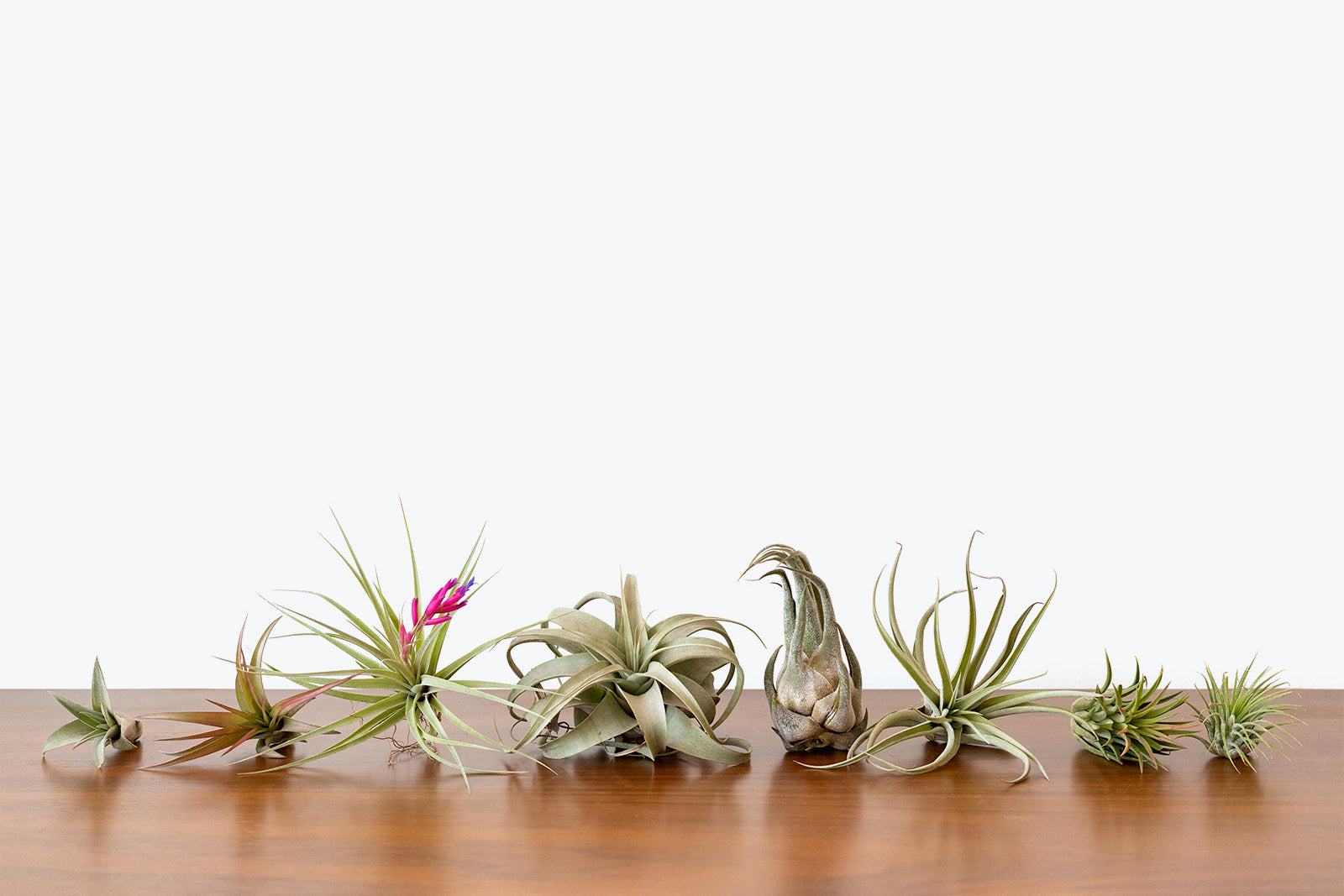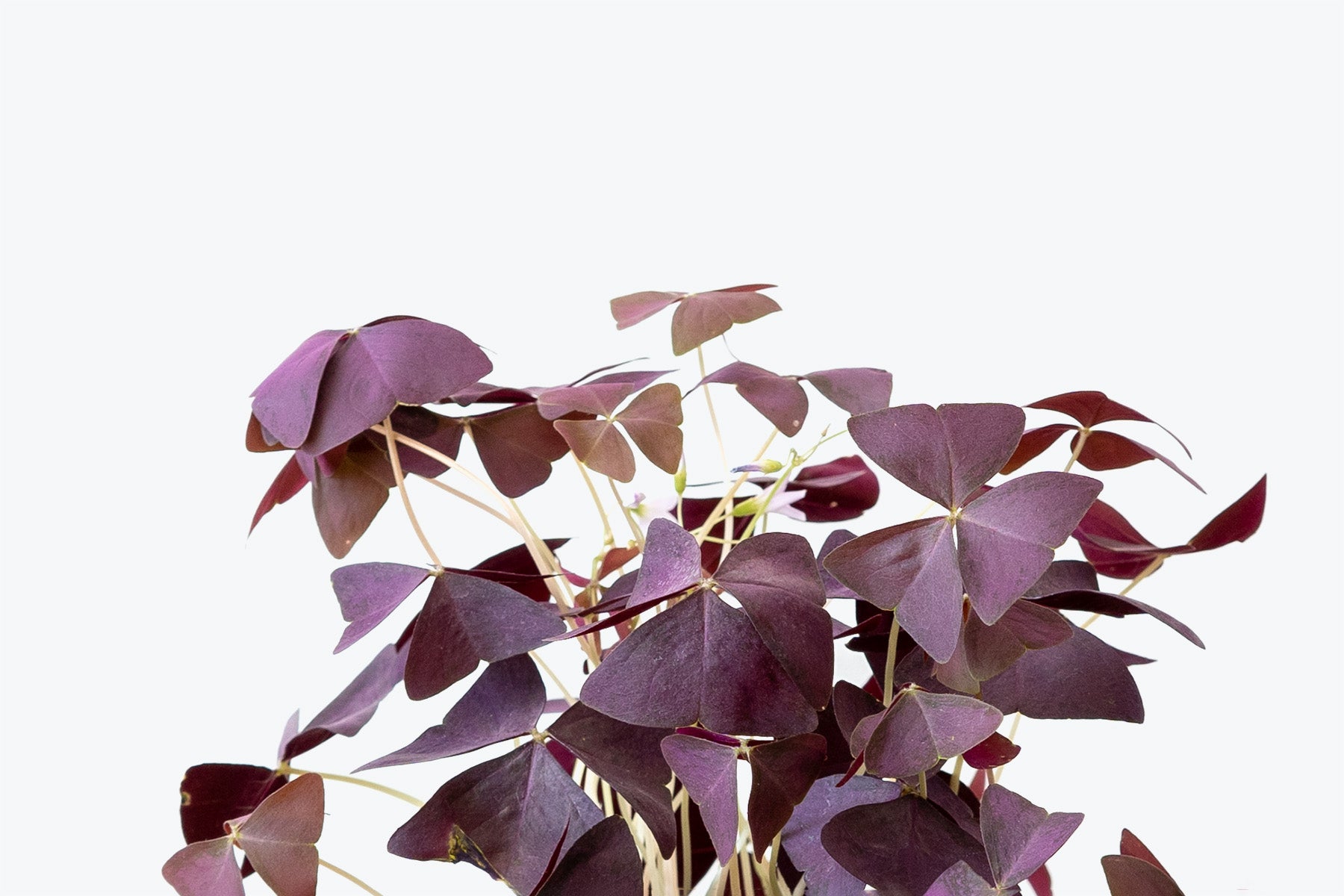
How to Take Care of Your Air Plant
Air plants are magical, mysterious creatures. It's all in the name, but the fact that they grow soil-less, latched onto other plants, or wherever conditions permit, makes this unusual species a necessity for any houseplant parent. In their natural habitat, you can find them growing on telephone wires, tree branches, bare rocks, and more! With the proper care, and the cutest accessories, you can place air plants just about anywhere in your home, as long as they are receiving adequate light.
Did you know? Air plants are actually a part of the Bromeliaceae Family, which is also home to Bromeliads and Pineapples!
The best part is, there is no need for soil to hold you back with where you place it, there are plenty of decorative wall hangers or cute planters for them to rest in, wherever you would like to place them. These interesting places can range from the fridge in your kitchen (attached to a magnet), to sitting atop a decorative bowl filled with beautiful stones and shells. They can even be mounted onto bark, drift wood or moss using clear fishing line, or twine, to make a more "natural" looking display.

Although air plants do not need any soil, they are epiphytes, meaning they still have root systems, which they use to latch on to their homes and obtain their nutrients and moisture (from air, rain, water, or debris). The Tillandsia genus is vast and there are plenty of varieties, most of which require similar care, so let's get in to how to care for your new air plant!
Light Requirements
As with all other plant care that I write about, getting the light right for your air plant is the number one most important care step. If we think of where they grow in their natural habitats, where some grow under canopies of trees in the tropics and others grow in drier climates, we also have to adjust care for their specific needs. As a general rule of thumb, most air plants require bright, indirect light, as too much strong sun will burn their foliage.
△ Airplant Trio
The lowest light conditions that they can handle would include the following:
- A few feet away from a North-facing window that is not blocked by any trees or neighbouring apartment buildings
- A few feet away from South or East-facing windows
- Next to a South, West, or East facing window that is facing a courtyard or is blocked by a nearby building
Even though an air plant can handle these conditions, it is best just to give them what they are looking for, and that is bright, indirect light. Not only that, the air plant is the easiest plant to give it exactly what it wants as they can be placed essentially anywhere since they are not bound to a pot!
Here are the ideal light conditions for you to keep your plant looking lush and full:
- Next to a South or West-facing window, making sure there are blinds to block any harsh sun that may burn the plant
- A few feet away from a South or West-facing window
- Next to an East-facing window (morning sun will not burn your plant)
I'll be honest, my air plants were definitely not getting the light that they needed, and it showed, so as I was writing this article, I moved mine to make sure they could get the best light possible. We are all still learning when it comes to plant parenthood!
For those of you that want to get even more specific in your care, look at the foliage of your air plants. If your plant has light, greyish-green leaves, and lots of trichomes (tiny, hair-like growths on the leaves), then this variety will prefer brighter light, even some direct sun is ok as they grow naturally in drier regions. On the other hand, air plants with greener leaves and less visible trichomes prefer indirect, filtered light.
Watering Requirements
Now, air plants don't live on air alone, they still require sufficient water to live and thrive. In their natural habitat, they get the nutrients they need with the trichomes on their leaves and the roots they produce when they are latched on to their home. In our homes, it is quite different, as the air circulation is poor and there aren't many nutrients blowing around our homes. That's why it is very important that you water your air plants when they need it, you just need to find the right balance for your home. So if you have a home on the drier side, you may need to water more often, or if you have a humid home, be careful not to overwater and cause the whole plant to rot.
△ Tillandsia Xerographica
When your plant is producing brown, crispy tips, this is often a sign of under watering, while yellow, soggy looking leaves is a sign of overwatering!
Only water your air plant when it is completely dry, this should be about once a week but again, you need to keep an eye on your home conditions. Find the right balance! When it is time to water again, submerge your air plant fully into water for about 30 minutes, or up to an hour. It is best to use distilled, rain, or bottled water when you soak your plants as the minerals in tap water will clog the trichomes, not allowing the plant to absorb any nutrients!
This next step in the watering process is very important: Always shake off any excess water and place the plant upside down on a towel, in a bright spot, to dry for a few hours. If you let water sit at the base of the leaves where they meet the stem, there is a high possibility of rotting and therefore ruining your beautiful air plant.
Again, for those of you who want information for your specific air plants, those with more of a silver foliage, and more trichomes, are the most drought tolerant, so they won't need as much water as their greener counterparts, who will need to be watered more often. Also, varieties with thinner leaves, and less trichomes, often grow in areas that receive more rain while the thicker leaved varieties can tend to handle drier conditions. We've all lost an air plant to either overwatering or under watering so don't be too hard on yourself when you're still trying to get the hang of these little guys!
Humidity
When it comes to humidity, refer to what I have mentioned above. Those that are from drier climates need less humidity than those from rainier environments. Although most air plants do prefer humid environments, there are some things to look out for.
- Proper air circulation is key for most air plants, as that is how they get their nutrients in their natural habitats and ensures they do not rot after getting wet
- Keep them out of enclosed terrariums, as there is no air flow and the dampness will surely cause the air plant to rot. There is plenty of cute glassware designed to home air plants that have openings to encourage this circulation!
- Air plants like warm days and cool nights, so a 10 degree drop in the evening is actually preferred by these little guys
- If you increase the humidity around your air plant, make sure it is getting proper light so as to avoid rotting at the core of the plant
There are lots of options to make your space, or the space surrounding your air plant, more humid. You could set a cup of water next to the air plant so that as it evaporates, the air surrounding your plant is humid, or even invest in a humidifier if that is something you are able to do, as they can also help with increasing the humidity for your other tropical plants (as I am sure you own more than just an air plant... don't we all!).
Although misting is not enough to water an air plant, it is a great way to increase the humidity around your plant for a short time. Mist every other day, in between soaks of your air plant, as long as the plant looks relatively dry, you don't want to mist it too much so as to cause it to rot. It is especially important to do this during the winter months as our homes are very dry from our heating systems. The more silver the foliage, the more humidity is needed!
Fertilizing
Air plants are not so picky and only need a water-soluble fertilizer about once a month.
They will flower eventually but once you see that flower, that marks the end of the air plant, since they only flower once in their lives. However, they do produce offsets, or pups, at the base of the plant, either before, during, or after they flower, which is always exciting to see! When this happens, you want to wait until the pup is a third to half the size of the mother plant before carefully removing it, since the mother plant is where it gets its nutrients from. You can also just leave the offsets on the mother plant and just have one big clump of air plants all together!
Toxicity
Thankfully, air plants are not poisonous to people or the majority of cats and dogs. However, they look just like a toy to your furry little felines so make sure to keep them out of reach of those claws!
Common Pests Problems
From my experience, and from the research I have done, pests are not a huge problem when it comes to air plants, and they are relatively easy to get rid of as you can easily soak your plant to rid yourself of any unwanted visitors! The following points are the few problems that can happen with air plants, but there are lots of simple solutions:
Scale:
If you notice a sticky, honeydew-like sap on the leaves or brown “lumps” along the leaves, you may be experiencing scale. Their damage includes yellowing and dropping of leaves (not just the oldest leaves) and very little new growth. They can be treated with any insecticidal soap, just make sure you treat your plant consistently for a few weeks to eliminate them.
Under watering:
When the tips of the leaves begin to brown and get crispy, that is a sign that your plant needs water right away! Even though under watering is more forgiving than overwatering, if you let your air plant sit for too long without sufficient water, damage will be done.
Overwatering:
In my opinion, this is the worst fate of them all for air plants, as there is no coming back from overwatering when it has gone too far. If any water is left to sit at the base of the leaves, rotting will occur, meaning the leaves will fall off the stem and the whole middle of the plant will become soggy and fall apart. To avoid this, make sure you always allow your plant to dry off completely after watering.
Air plants are the perfect addition to your collection, they are intriguing and unique! I've loved all the ones that I've ever owned, whether I was successful with them or not, because I have learned something from each of them. Once you get the basic care down, as with any other plant, they are a breeze to take care of and add beauty to any home. Good luck with your new little baby, or try one out if you have yet to experience one!








